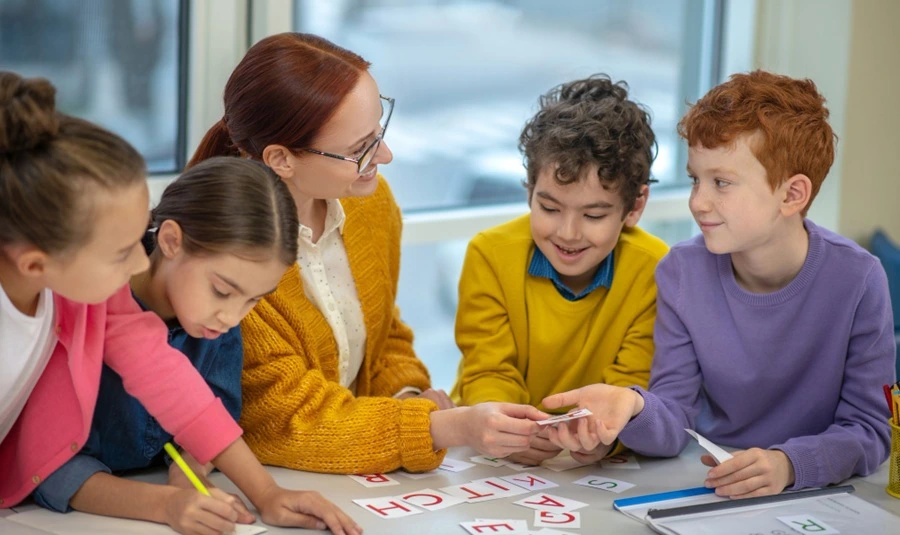Table of Contents
Walk into any good nursery or Montessori classroom and you’ll notice one thing immediately:
The teacher doesn’t just “manage” the class; she connects with children.
With her eyes, with her tone, with a tiny story hidden behind every instruction.
In the nursery years (roughly ages 2–6), communication and storytelling are not extras. They are the main tools teachers use to:
- Build language and vocabulary
- Shape behaviour gently
- Support emotional development
- Spark curiosity and imagination
Research shows that storytelling and rich oral language environments help preschoolers build vocabulary, grammar, listening skills, and even social-emotional understanding.
Reading and storytelling aloud are also strongly linked to better literacy, attention, and cognitive development later on.
For aspiring nursery and Montessori teachers in India, these skills can literally decide:
whether you’re just a “teacher on paper”…
or a magnetic storyteller children remember for life.
This blog will show you how to develop those skills, step by step, in a way that’s:
- Practical (you can start today)
- India-friendly (works in bilingual, crowded classrooms & homes)
- Montessori-aligned
- And aligned with how structured courses like Entri’s Montessori TTC build real classroom-ready teachers.
Register for the Entri Elevate Montessori Teacher Training Program! Click here to join!
Why Communication & Storytelling Matter So Much in Nursery Teaching
Preschoolers don’t learn mainly through worksheets.
They learn through voice, gesture, song, rhyme, story and everyday conversation.
1. Communication builds the foundation for all learning
Early oral language, the way children understand and use spoken words, is the base for later reading, writing and academic success.
A language-rich classroom:
- Exposes children to new vocabulary and sentence patterns
- Teaches them how to express needs, feelings and ideas
- Helps them follow instructions and participate in group activities
2. Storytelling is a shortcut to deep learning
Research on early childhood storytelling shows that stories:
- Expand vocabulary and language comprehension
- Support imagination and creativity
- Build empathy and emotional understanding by letting children “step into” characters’ feelings
- Improve attention span and listening skills
Montessori schools actively use storytelling to support language and overall development in a calm, child-centred way.
For Indian classrooms, often noisy, multilingual and full of energy, a teacher who can communicate clearly and tell a story well has a huge advantage.
How Young Children Develop Communication
1: What is the primary focus of the first plane of development in the Montessori method?
Between 2 and 6 years, children move from single words to full stories:
- They rapidly expand vocabulary
- Start using longer sentences
- Learn to take turns in conversation
- Begin to narrate events (“Yesterday I went to…”)
For teachers and parents, this means:
- Children need lots of chances to hear rich language
- They also need chances to speak, retell, ask and answer
- The adult’s job is not only to “instruct” but also to model good communication
In Montessori, we talk about a prepared environment, not just furniture and materials, but also how adults speak: slow, clear, respectful, and rich in real vocabulary.
Get Certified & Start Your Montessori Career
Montessori Teacher Training Course by Entri App: Gain expert skills, earn certification, and kickstart your teaching career.
Join Now!Core Communication Skills Every Nursery Teacher Should Build
You don’t need a “perfect” accent or a loud voice. You need clarity, warmth and responsiveness.
1. Clear, calm voice and articulation
- Speak slowly and clearly, especially when introducing new words
- Use short, simple sentences for instructions:
- “Please put your shoes on the rack.”
- “Let’s sit in a circle.”
- “Please put your shoes on the rack.”
- Vary your tone, gentle for reassurance, upbeat for storytelling, but avoid shouting
Remind yourself: your voice should feel like a safe, predictable background in the classroom, not constant noise.
2. Warm, responsive listening
Good communication is not just talking; it is listening well:
- Give eye contact when a child speaks
- Bend to their level when possible
- Repeat or rephrase what they say:
- Child: “Doggy runned.”
- You: “Yes, the dog ran fast!”
- Child: “Doggy runned.”
This “responsive talk” builds vocabulary and grammar naturally.
3. Rich but accessible vocabulary
Don’t be afraid of strong words; just pair them with simpler ones.
- “This story is about a generous (very kind) girl.”
- “The pond is shallow (not very deep).”
Children pick up sophisticated words when used in real context, especially in stories.
4. Non-verbal communication
Your face, hands and body communicate as much as your words:
- Smile often and genuinely
- Use open gestures (palms up, inviting) instead of pointing aggressively
- Nod, lean in, and show interest when children speak
- During stories, use expressive but not scary facial expressions
5. Handling multiple languages (very Indian reality)
Many Indian children grow up with two or more languages (for example, Malayalam at home, English at school).
You can:
- Tell stories in the home language sometimes, and in English other times
- Repeat key words in both languages:
- “This is a mango – maanga – sweet fruit.”
- “This is a mango – maanga – sweet fruit.”
- Encourage children to describe pictures or events in any language, then gently add English phrases
Research shows strong early language (even in the home language) supports later literacy in school languages.
Storytelling: Your Superpower in the Nursery & Montessori Classroom
Storytelling is much more than “just reading a book”.
When you tell or read a story:
- Children hear new words and sentence patterns
- They practice listening and imagining
- They learn about emotions, morals and social situations
- You build a close teacher–child bond through shared attention and fun
Reading and storytelling aloud have been repeatedly shown to boost vocabulary, comprehension, empathy and overall cognitive development.
In Montessori classrooms, storytelling is often used to:
- Introduce new concepts gently
- Connect practical life and sensorial activities to wider themes
- Build peace, grace and courtesy through character-based stories
Practical Ways to Develop Your Storytelling Skills
You don’t have to be born a “natural” storyteller. You can train yourself.
1 Start with reading aloud – every single day
Even 10–15 minutes daily can transform your communication style.
- Choose age-appropriate picture books with big illustrations
- Read slowly, using different voices for each character
- Pause to ask simple questions:
- “What do you think will happen next?”
- “How does the rabbit feel now?”
- “What do you think will happen next?”
Evidence shows that regular reading aloud sessions strengthen vocabulary, listening, comprehension and emotional understanding.
Teacher tip: Record yourself reading a story on your phone once a week.
Listen back: Is your voice clear? Too fast? Too flat? Adjust next time.
5.2 Use voice, pace and pause intentionally
Good storytellers play with:
- Volume – softer for secrets, louder for surprises
- Speed – slow for suspense, fast for exciting chases
- Pauses – to let children guess or imagine
You don’t need drama-school acting. Just small variations make stories engaging.
3 Add gesture, face and body
- Use your hands to show “big/small”, “up/down”, “open/close”
- Let your face show shock, joy, confusion (in a gentle way)
- Turn slightly towards different “sides” of the room when different characters talk
This multi-sensory input helps children follow the storyline and stay engaged.
4. Use repetition and rhyme
Young children love repetition. It helps them predict, join in and feel confident.
- Pick stories with repeated lines:
- “I’ll huff and I’ll puff and I’ll blow your house down!”
- “I’ll huff and I’ll puff and I’ll blow your house down!”
- Or create your own repeated phrase the class can chant together
- Include rhymes and rhythmic language, they support memory and phonological awareness.
5. Bring in simple props & puppets
You don’t need fancy materials:
- A dupatta becomes a river, cave or magic carpet
- A spoon can be a “microphone” for show-and-tell
- Sock puppets or paper-bag puppets can act out stories
In Montessori, we’re careful that props support the story – they don’t distract or over-stimulate. Keep them simple, concrete and meaningful.
6. Use Indian stories and local context
For geo-relevance and emotional connection:
- Use Panchatantra, Jataka tales, Akbar–Birbal, Tenali Raman, regional folk tales
- Include stories set in Kerala, Tamil Nadu, Delhi, Mumbai, villages, markets, buses
- Bring in festivals, monsoon, grandparents, trains, etc.
Children learn better when stories feel close to their real world.
Get Certified & Start Your Montessori Career
Montessori Teacher Training Course by Entri App: Gain expert skills, earn certification, and kickstart your teaching career.
Join Now!Montessori-Inspired Ways to Build Communication & Storytelling
Montessori isn’t about performing for the child; it’s about inviting the child to enter the story and language themselves.
Create a “language corner” or story nook
In a Montessori or nursery room, you can set up:
- Low shelf with picture books, story cards, puppets
- A small rug or mat for storytelling time
- A basket of objects (fruits, animals, transport) for naming and story-making
This turns language into hands-on work, not just listening.
Link storytelling to practical life & sensorial activities
Examples:
- After a story about washing vegetables, children do real washing in Practical Life
- After a story about colours, they explore colour tablets in the Sensorial area
- After a train-journey story, they arrange picture cards in sequence
This integration is deeply Montessori, connecting language to movement and real-life experiences.
Follow the child’s interest (observation)
Montessori teachers spend time observing:
- Which stories children repeat
- Which topics fascinate them (animals, vehicles, family, food)
- Which children are shy to speak but love listening
By observing, you choose stories and conversations that meet their current interests and language level, which makes communication more meaningful.
4. Encourage children to tell stories back
Don’t keep storytelling one-way.
- Ask children to retell parts of the story
- Use sequencing cards with three or four pictures
- Encourage “personal stories”:
- “Tell us about a time you went to the zoo.”
- “Tell us about a time you went to the zoo.”
- Accept mixed language (English + mother tongue) and gently model clearer sentences
Storytelling is one of the most effective ways to improve young children’s speaking skills and oral proficiency.
A Simple 30-Day Practice Plan for Aspiring Nursery & Montessori Teachers
You can treat communication and storytelling as a skill-building project.
Week 1: Voice & Clarity
- Read one short children’s story aloud daily (even if only to yourself)
- Record yourself twice this week and listen back
- Focus on clear pronunciation and slower pace
Week 2: Expression & Body Language
- Add gestures and facial expressions to your daily reading
- Practice telling a 2-minute story without book (e.g., “The Lost Balloon”)
- Stand in front of a mirror for one story and notice your body posture
Week 3: Interaction & Questions
- Practice pausing to ask open questions during the story
- With real children (nephew, neighbour, students), encourage them to guess endings or feelings
- Try retelling the same story two different ways, once very simple, once with richer vocabulary
Week 4: Montessori Integration
- Take one story and plan one Practical Life or Sensorial activity linked to it
- Create 3–4 sequencing cards for the story
- Encourage one child (or more) to retell with the cards while you just guide
By the end of 30 days, you’ll be noticeably more confident, even if you’re just starting.
How Parents Can Support Communication & Storytelling at Home
Even if you’re not a teacher, you play a huge role in your child’s communication skills.
Make reading or storytelling a daily ritual
Studies are now warning that fewer young parents are reading to their children regularly, which can affect language development and bonding.
Even 10–15 minutes of bedtime reading:
- Gives rich vocabulary and sentence patterns
- Creates emotional security
- Builds attention span
Talk about everyday life
- Describe what you’re doing: “I am cutting tomatoes, they’re red and juicy.”
- Ask simple “why/what/how” questions
- Let your child help with small tasks and talk through them
Limit screens during “story time”
If you use screens, keep them away from reading/ storytelling moments. The power is in shared attention on one story, not in background TV.
How Entri’s Montessori TTC Course Supports Communication & Storytelling Skills
Formal training helps you turn these ideas into professional strength.
Entri’s Montessori Teachers Training Course (including PG Diploma) is designed to prepare you for real preschool and Montessori classroom roles with:
- Montessori philosophy & language modules
- How to present language materials
- How to use precise, respectful teacher talk
- How to present language materials
- Practical training & internships
- You practice presenting stories, lessons and activities to children
- You get feedback on clarity, classroom presence and communication
- You practice presenting stories, lessons and activities to children
- Spoken English support
- PG Diploma programmes include spoken English sessions, helping you speak with confidence in English-medium schools
- PG Diploma programmes include spoken English sessions, helping you speak with confidence in English-medium schools
- Montessori teacher skills
- As Entri’s course pages highlight, Montessori teachers are also language trainers, they use conversation, storytelling and other activities to improve children’s language.
- As Entri’s course pages highlight, Montessori teachers are also language trainers, they use conversation, storytelling and other activities to improve children’s language.
- Placement assistance
- With globally recognised certification (CEED International, UK bodies), you can target Montessori and nursery roles in India and abroad.
- With globally recognised certification (CEED International, UK bodies), you can target Montessori and nursery roles in India and abroad.
If you’re serious about becoming a high-quality nursery / Montessori teacher, a structured course like Entri’s helps you practice these communication and storytelling skills with expert guidance, not just theory.
Key Takeaways:
- Communication and storytelling are core tools, not extras, in nursery and Montessori teaching.
- Rich oral language environments support vocabulary, comprehension and later literacy.
- Storytelling boosts imagination, empathy, attention and social-emotional growth.
- Great nursery teachers develop:
- Clear, warm voice
- Active listening
- Rich but simple vocabulary
- Expressive face and body language
- Comfort with bilingual situations
- Clear, warm voice
- You can train yourself with daily reading aloud, recording your voice, using gestures, props and questions.
- Montessori-inspired practice means:
- Prepared language corner
- Story-linked practical life and sensorial activities
- Observing children and following their interests
- Encouraging children to retell stories themselves
- Prepared language corner
- Parents can support communication at home through daily storytelling, conversation and low-screen routines.
- Entri’s Montessori TTC helps aspiring teachers systematically develop these skills with theory, practice, spoken-English support, and placement assistance.
Final Word
You don’t need to be a born performer to be a great storyteller for children.
You need:
- A little practice
- A love for stories
- A genuine respect for children’s minds
Whether you’re a parent reading at bedtime or an aspiring Montessori teacher standing in front of a class, every story you tell is shaping how a child thinks, feels and speaks.
If you’re ready to turn that natural love for children into a professional career, exploring a structured programme like Entri’s Montessori TTC can give you the training, confidence and certification to walk confidently into any nursery classroom, and start your story there.
Get Certified & Start Your Montessori Career
Montessori Teacher Training Course by Entri App: Gain expert skills, earn certification, and kickstart your teaching career.
Join Now!Frequently Asked Questions
Why are communication skills important for nursery teachers?
Communication helps teachers connect with children, guide classroom behaviour, and support emotional and language development during early learning years.
How does storytelling help young children?
Storytelling builds imagination, improves vocabulary, enhances listening skills, and helps children understand emotions and moral values.
What type of communication should a nursery teacher use?
Teachers should use simple language, clear instructions, warm tone, expressive gestures, and positive reinforcement to help children feel safe and engaged.














